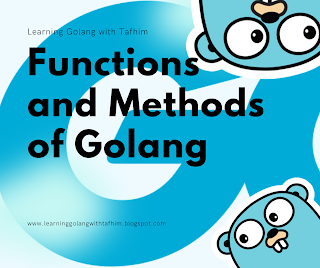Overview
In this blog i am going to talk about the functions and methods in golang. which is a important topic in go. if you have not read the previous blog or do not have a basic knowledge about go the i would suggest you to have a look at my other blog.
Functions
you can declare a function as below. you don't need to declare return type unless your not returning something from your function. you get the return value in a way that is explained in the example code .
func <function name >(<parameter> <parameter type>) (<return type>){}Example Code :
package main
import ("fmt")
func main() {
test1() // example 1
sum := test2() // example 2
fmt.Println("sum =",sum)
sum2,error:= test3(30,40) // example 3
fmt.Println("sum 2 =",sum2,error)
sum3,_:= test3(80,60) // example 4
fmt.Println("sum 2 =",sum3)
sum4,_:= test4(80,60.34) // example 5
fmt.Println("sum 2 =",sum4)
}
func test1() {
fmt.Println("hello from test 1")
}
func test2() int {
sum := 20 + 30
return sum
}
func test3(a,b int) (int,error){
sum := a + b
return sum,nil
}
func test4(a int,b float32) (float32,error){
sum := float32(a) + b
return sum,nil
}
output :
hello from test 1
sum = 50
sum 2 = 70 <nil>
sum 2 = 140
sum 2 = 140.34
if you can see in test3 function we are grabbing the returned value by declaring the variable. In golang if you do not grab the value that is returning from the function then it will show an error. to avoid that error you need to fallow the test4 example of the function.
Methods
there is no classes in golang. instead of class they use struct and add a function to the struct so that it can be used as method. you can bind a method to a struct as below.
func (<variable name> <struct name >) <function name >
(<parameter> <parameter type>) (<return type>){}
there is a sudden way you can use construct method in golang. it will be explaining in CRUD with golang blog.
| Previous Blog | Next Blog |
|---|---|
| Collection of golang | Program flow of golang |

Comments
Post a Comment